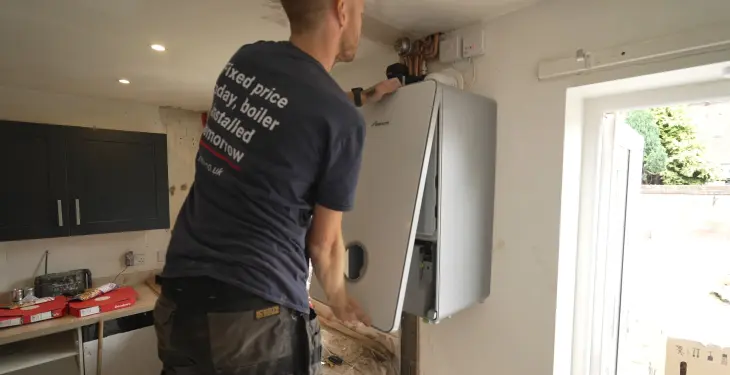



Written by Stephen Day
Gas Safe Engineer
Updated: 30th May, 2025
Installing a boiler in a bathroom can be safe and legal in the UK, but specific regulations must be followed. Key factors include the type of boiler and its placement in relation to the bath or shower.
Get a new boiler quote, save up to £550 per year (0% APR available).
Installing a boiler in a bathroom might seem like a convenient choice, especially in homes where space is at a premium. Bathrooms offer a central location for heating systems, leading to efficient heat distribution. Yet, safety and legal considerations are vital when making this decision. Installing a boiler in a bathroom is legal but must meet strict UK safety standards to ensure the safety of all household members.
Safety regulations outline specific zones within a bathroom where electrical and heating appliances can be safely placed. It's crucial to ensure that a qualified engineer conducts any boiler installation to adhere to these rules. Boilers can be smartly concealed within bathroom cabinets, maintaining aesthetics without sacrificing compliance or safety.
For those considering installation, understanding the regulatory guidelines and consulting with a certified professional is essential. This approach ensures not just compliance but also enhanced safety for everyone in the household.
Get a quote in 60 seconds, fitted as fast as next day!
0% APR finance available.
Installing a boiler in a bathroom can be safe and legal in the UK, but specific regulations must be followed. Key factors include the type of boiler and its placement in relation to the bath or shower.
Gas boilers must comply with legal requirements like the Gas Safety (Installation and Use) Regulations 1998. Installation should be performed by a Gas Safe registered engineer. This helps ensure safety and regulatory compliance.
For oil boilers, there are similar safety regulations to adhere to, ensuring safe operation at home. Oil boilers might need separate considerations, especially for ventilation and flue positioning.
Boilers should be placed outside specific safety zones in the bathroom. Typically, the boiler should not be within 60 cm of a bath or shower to avoid water exposure. Installations must meet the standards set out in the IEE Wiring Regulations, known commonly as BS 7671.
Proper ventilation is crucial. Without it, dangerous gases could accumulate. Therefore, when planning the heating system, taking into account the room’s size and ventilation options is important.
Carbon monoxide alarms are legally required if the room has a fixed combustion appliance, including central heating systems. This is especially important for properties that rely on gas boilers.
Always check with local authorities or consult experts. Regulations may have specific stipulations based on the area or building type. This ensures the installation is both safe and legal.
In the UK, bathroom zones define areas of risk regarding water and electrical appliances. These zones guide the safe placement of items like boilers. Zone 0 is inside the bath or shower and requires low voltage appliances. Zone 1 is above the bath or shower up to 2.25 metres high. Zone 2 extends 0.6 metres beyond, including areas around sinks.
Zone-free Areas:
These are further away from water sources and are better for placing a boiler. Boilers in these areas reduce the risk of contact with water and ensure safer operation.
Electrical Regulations:
Boilers should be installed in line with the wiring regulations. This includes having no electrical switches outside a protective cupboard, keeping them dry and safe from accidental water contact.
Hot Water and Pressure:
Ensuring good water pressure is key for boiler efficiency. Placement affects the flow rate to mixers, power showers, and digital showers. Incorrect placement can lead to low water pressure, impacting hot water supply.
Safety Measures:
A pressure gauge should be accessible to monitor water pressure levels. This ensures that the system maintains optimal function. A safe installation might need a shower pump to boost flow if located far from water sources.
In essence, effective boiler placement within bathroom zones ensures both safety and functionality. It protects against water-related hazards while maintaining efficient hot water flow to household fixtures.
When installing a boiler in a bathroom in the UK, several important regulations ensure safety and efficiency.
Gas Safety (Installation and Use) Regulations 1998:
These require that any gas appliance, like a combi boiler, is installed by a Gas Safe registered engineer. This ensures that installations meet legal safety standards.
Zone Regulations:
Bathrooms are divided into zones based on their proximity to water sources, which affects where a boiler can be positioned. A boiler should generally be installed in Zone 3, where there’s no direct contact with water.
IP (Ingress Protection) Ratings:
Electrical components of the boiler need to have an adequate IP rating. This rating shows the level of protection against water, ensuring electrical safety in moist conditions.
Pipework and Condensate Pipe:
The installation of pipework, including the condensate pipe, must comply with regulations to prevent freezing. Pipes should be properly insulated, especially in unheated spaces, to prevent issues in cold weather.
Ventilation and Flues:
Adequate ventilation is critical in bathroom installations to prevent the build-up of harmful gases. Flues must be correctly positioned and comply with regulations to ensure safe expulsion of exhaust gases.
Installation Costs:
While installing a boiler in a bathroom can be convenient, consider the installation costs, which may vary based on the type of boiler and additional modifications required to meet these regulations. Always consult with a professional to get an accurate cost estimate and ensure compliance.
Aesthetic Appeal
Concealing a boiler, especially a combi boiler, in the bathroom can create a tidy and streamlined look. This can enhance the overall aesthetic of the room, making it appear more spacious and modern. With the boiler out of sight, the bathroom feels less cluttered and more pleasant.
Space Efficiency
Bathrooms often have limited space. By concealing the boiler, homeowners can free up room for other essentials. This practical solution makes better use of available space and allows for additional storage options, such as shelves or cabinets.
Safety Considerations
When concealed properly, boilers are safe in bathrooms. Modern combi boilers are designed to meet high safety standards. They can be neatly enclosed in cabinets that meet manufacturer guidelines, ensuring proper ventilation and access for maintenance.
Temperature Control
Equipping the concealed boiler with a smart thermostat enhances ease of use. A smart thermostat allows for precise temperature control, which can optimise energy usage and improve comfort. Residents can adjust heating settings with ease, ensuring the bathroom is warm when needed.
Noise Reduction
Enclosing the boiler can reduce the noise generated during operation. This can be particularly beneficial in small living spaces, where noise can be disruptive. A quiet bathroom environment is more relaxing and contributes to a peaceful home atmosphere.
When installing a boiler in a bathroom, ensuring safety is absolutely crucial. Gas safety is a vital aspect that needs careful consideration.
Regular boiler service is important. A certified professional should check the system at least once a year. This helps in spotting any potential issues early and maintaining efficiency.
It's crucial to ensure that the installation complies with UK safety standards. The installer must be listed on the Gas Safe Register. This assures the work is done safely and competently.
Proper boiler maintenance is key. This means keeping the boiler clean and checking for any signs of wear. Address any unusual noises or leaks immediately.
The pilot light should always be checked. If it frequently goes out or shows signs of discolouration, it could indicate a safety issue. A blue flame signifies proper function, whereas a yellow or orange flame might suggest a problem.
Adequate ventilation is essential. Make sure there is enough space around the boiler to allow air to circulate. This prevents overheating and allows the boiler to work efficiently.
Keep flammable materials away from the boiler. Items like towels or cleaning products should not be stored nearby. These could present a fire hazard.
Lastly, ensure there is easy access for servicing. The boiler should be positioned in such a way that technicians can work on it effortlessly. This can also make inspections more efficient and less time-consuming.
Selecting an engineer for installing a boiler in a bathroom requires careful consideration. The engineer you choose should be qualified and have the right certifications. One important qualification to look for is being a Gas Safe registered engineer. This ensures they meet strict safety standards.
Experience is another crucial factor. It's advisable to hire an engineer who specialises in bathroom installations to ensure they are aware of the specific challenges involved. Consider asking for references or viewing past work to gauge their capability.
Communication skills are vital too. A good engineer should clearly explain the installation process and address any concerns you may have. This ensures you understand the steps involved and any preparatory actions you need to take, like clearing the installation area.
Researching potential engineers is essential. Read reviews and gather feedback from previous clients to get an idea of their reputation. Check for any complaints or issues raised against them, as this can provide insights into their reliability.
Cost is another consideration. Request detailed quotes from multiple engineers. Ensure the quote covers not just the installation but also potential extras, such as system flushing or adding a Magnaclean filter. This helps you plan your budget effectively.
By prioritising skills, qualifications, and communication, you can confidently choose the right engineer for your bathroom boiler installation.
Concealing a boiler can enhance the overall appearance of your bathroom. There are several ways to do this while ensuring it remains safe and efficient.
Cupboards or Cabinets
A common way to hide a boiler is by placing it inside a cupboard. Choose materials that offer good ventilation and are heat-resistant. Ensure there is enough space for routine maintenance.
Decorative Panels
Another option is to use decorative panels. These can blend seamlessly with the bathroom decor. Opt for panels that are easy to remove, allowing easy access to the boiler.
Insulation
It's important not to overlook insulation when concealing a boiler. Insulation can help maintain boiler efficiency by keeping the heat within. Use materials that align with safety regulations.
Boiler Brands
Choosing the right boiler brand can simplify the task of concealing it. Some offer compact designs specifically designed for smaller spaces. Researching brands beforehand is advised.
Ventilation
Regardless of the concealment method, proper ventilation is key. Ventilation prevents overheating and ensures the boiler functions optimally. It's crucial to comply with safety standards.
Each of these solutions offers a unique way to blend safety and aesthetics, ensuring your bathroom maintains a sleek and modern look.
The kitchen is a common choice. It often has the necessary plumbing and ventilation. Housing a boiler here keeps it out of the way while still accessible.
Ideal for a system or regular boiler, a utility room provides space for a water tank. It also keeps noise and clutter separate from living areas.
If your home has a gravity-fed system, an airing cupboard is practical. It can keep the water tank warm, enhancing efficiency.
Placing a boiler in the loft can free up valuable space below. Ensure the loft is insulated to prevent freezing in winter.
The garage offers ample space and can accommodate different types of boilers. Ensure proper insulation and protection against cold temperatures.
A small boiler, like a combi, might fit into a cloakroom. This makes use of unused space while centralising heating equipment.
Using these spaces strategically can maximise living space and maintain aesthetic appeal. Properly considering each option aids in efficient home heating.
When considering the installation of a boiler in a bathroom, the space constraints and compliance with safety regulations play a crucial role. If you’re planning to move or replace your boiler, it’s important to factor in both new boiler cost and the additional expense of ensuring the installation meets legal bathroom zones and safety standards.
Here at iHeat, new boiler cost starts from £1,845, and the ease of installation in a bathroom depends on the specifics of your property and heating system.
Get a quote in 60 seconds, fitted as fast as next day!
0% APR finance available.
Last updated: 30th May, 2025

Written by Stephen Day
Gas Safe Engineer at iHeat
Stephen Day is a Gas Safe registered and FGAS certified engineer with over 20 years of hands-on experience in the heating, cooling, and renewable energy industry, specialising in boiler installations, air conditioning, and heat pump systems.
LinkedInArticles by Stephen Day are reviewed by iHeat’s technical team to ensure accuracy and reliability.

22nd December, 2025
Based on data from over 7000 boiler installations completed by iHeat in the past 12 months...
 Read Article
Read Article

22nd December, 2025
Here’s a quick roundup of the best combi boilers for 2026.
 Read Article
Read Article

22nd December, 2025
When your old boiler breaks down and it comes time to replace it with a new one, it might...
 Read Article
Read Article
No obligation. Takes less than 60 seconds.